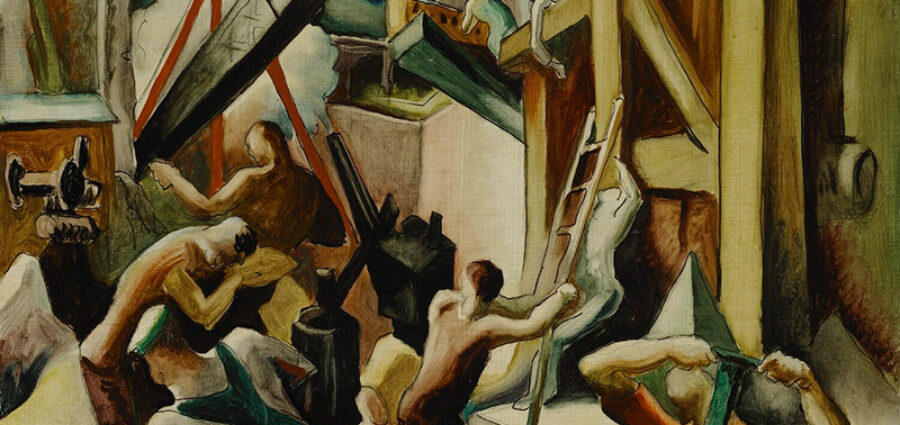The Frist Art Museum presents American Art Deco: Designing for the People, 1918–1939, an exhibition that offers an in-depth examination of an international style that manifested stateside in decorative arts, fine arts, architecture, and design during the 1920s and 1930s. Co-organized by The Nelson-Atkins Museum of Art, Kansas City, Missouri, and Joslyn Art Museum, Omaha, Nebraska, American Art Deco will conclude the Frist’s 20th-anniversary year and be on view in the Ingram Gallery from October 8, 2021, through January 2, 2022.
Appropriately presented within the Frist’s own art deco interior during the museum’s 20th-anniversary year, the exhibition examines not only the glamour and optimism of the 1920s, but also the impact of the Great Depression in the 1930s. Approximately 140 works of art, including paintings by Thomas Hart Benton, Aaron Douglas, and Grant Wood; a 1930 Ford Model A; and a broad array of decorative objects—furniture, glassware, vases, and jewelry—will immerse guests in the dynamic interwar period.
As is evident in iconic structures like the Chrysler Building in New York, the Delano Hotel in Miami, and the Griffith Observatory in Los Angeles, architecture was one of the most common idioms in which the art deco style was utilized in the United States. The Frist’s building—formerly Nashville’s postal headquarters—was built in 1933–34 by local firm Marr & Holman and financed by the US Treasury Department’s Office of Construction. The lobby contains examples of art deco–style colored marble and other stone geometric forms on the floor and walls, as well as cast-aluminum doors and grillwork featuring symbols of local industry. “We hope that our building provides the perfect context for this show that reflects this complex age of American zeal and loss,” says Frist Art Museum senior curator Katie Delmez.
The years between the two world wars saw great social, political, and cultural change in the United States. “Hundreds of thousands of African American families left the South for economic opportunities and hopes of racial equity in northern, midwestern, and western cities; women won the right to vote through the Nineteenth Amendment to the Constitution in 1920; and artists adopted modern streamlined styles developed in Europe using new production technologies and materials,” says Delmez. “The range of works in this exhibition allows audiences to consider both the optimism and glamour of this moment in our nation’s history and the devastation and discrimination that was also prevalent.”
American Art Deco opens with a selection of objects made in Paris during the 1920s, when a new style centered on sleek lines, geometric forms, and luxurious materials was emerging. The style came to be known as art deco after the 1925 Exposition Internationale des Arts Décoratifs et Industriels Modernes (International Exposition of Modern Decorative and Industrial Arts), in which participating designers promoted the new aesthetic. “Many American artists and patrons saw this work either directly or through reproductions and sought to recreate it stateside,” says Delmez. “Although American art deco objects retain the emphasis on angularity and simplicity seen in those produced in France, they were generally made with less expensive materials and therefore available to a wider class of consumers.”
The exhibition features several important works by Aaron Douglas, photographer James Van Der Zee, and other notable figures associated with the Harlem Renaissance. Douglas came to Nashville from New York to create a series of murals in his signature style of silhouetted figures and radiating bands of color for Fisk University in 1930. Ten years later, he established the art department at Fisk, where he taught for the next 26 years.
The optimism of the Jazz Age and the so-called “Roaring Twenties” came to an abrupt end with the stock market crash of 1929. The cascading effects of its collapse were compounded by devasting erosion throughout parts of the Midwest in the early 1930s caused by drought and unsustainable farming practices. Paintings like Grant Wood’s Stone City, Iowa (1930) reflect an idyllic rural life that appealed to isolationist Depression-era audiences. Photographs by Dorothea Lange and Arthur Rothstein, both hired by the Farm Security Administration, document the continuing despair experienced by many people during this time. The impulse to create beautiful domestic spaces remained, however, and firms like the Indiana Glass Company were able to use molds to mechanically produce a range of beautifully colored and patterned glassworks that were accessible to the middle class.
The exhibition concludes with a section devoted to modern everyday living, featuring mass-produced household items such as vacuum cleaners, irons, radios, and more affordable ceramic dishes. The designs reflect the streamlined style of the machine age.
Exhibition Credit
Organized by The Nelson-Atkins Museum of Art, Kansas City, Missouri, and Joslyn Art Museum, Omaha, Nebraska
Supporter Acknowledgment
Platinum Sponsor: HCA Healthcare/TriStar Health
Hospitality Sponsor: Union Station Hotel
Education and community engagement supporter: First Horizon
Spanish translation sponsor: Vanderbilt Center for Latin American Studies
The Frist Art Museum is supported in part by The Frist Foundation, the Metro Nashville Arts Commission, the Tennessee Arts Commission, and the National Endowment for the Arts.






